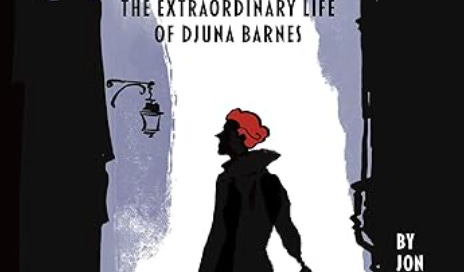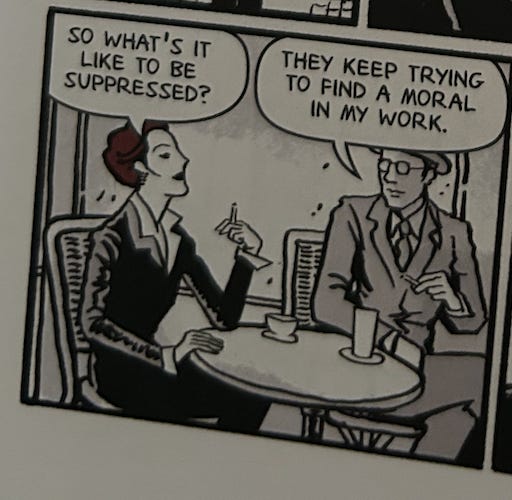DJUNA - Serio Comics 48 + Q&A with the Author Jon Macy!
DJUNA: The Extraordinary Life of Djuna Barnes written and drawn by Jon Macy, published by Street Noise Books
Serio Comics’ 4th Q&A!
This week we have a very special Q&A with Jon Macy who I had the pleasure of meeting last week at the reading of his graphic biography DJUNA at Book Soup in West Hollywood.
He was by far one of the most impressive yet approachable writers I’ve ever encountered.
I read DJUNA that night and the next day and was riveted by his brilliance.
We traded DMs and emails and as you’ll see his response to the Q&A adds to it.
I can’t wait for you to experience Jon Macy!
JON MACY
Jon Macy is best known for Teleny & Camille, his adaptation of the anonymous (but attributed to Oscar Wilde and his circle) Victorian novel Teleny, the winner of the Lambda Literary Award. He’s contributed to the anthologies Gay Comix, No Straight Lines, Qu33r, and Meatman Comics, and created the ‘Butch Lesbians of the 20s, 30s, and 40s’ coloring book series. His obsession with Djuna Barnes began in 1988, when he first picked up a copy of her novel Nightwood.
DJUNA

A graphic biography of Djuna Barnes: writer, artist, and queer radical of the Lost Generation in the Roaring 20s.
Djuna Barnes lived in a dazzling world filled with literary salons, innovative writing, and daring new art styles.
But it didn’t come easily.
She managed to work her way out of an abusive childhood growing up in a polygamous rural utopian community on Long Island.
She was determined to live an extraordinary life, and found herself socializing with the likes of James Joyce, Natalie Barney, Peggy Guggenheim, and T.S. Eliot in 1920s literary Paris.
Called the most famous unknown of the century, Djuna Barnes stood out for her brilliant writing, her biting wit, and her unique style.
Her novel Nightwood is considered by some to be one of the greatest lesbian love stories ever written.
But as the stock market crashed and the Lost Generation left Paris, her life began to unwind.
A fascinating window into the life of a woman whose enormous literary talent and provocative attitude were both celebrated and disdained by the world.
“Quite possibly the most bisexual graphic biography you will ever find”
That’s what Street Noise Books proudly shared on Instagram that the editor of Bi Women Quarterly, Robyn Ochs, said about DJUNA.
Macy shows Djuna’s trendsetting public lesbian relationship.
And her passionate affairs with bisexual men as well.
But also contextualizes her opinion of her own identity.
Pointing out that Djuna, like many queer people of her era, wouldn’t think of their sexuality in the way people identify it today.
Macy’s epigrammatic line: The only label she accepted was genius.
Could be the tag to a film adaptation…wink wink… ;)
Biographer’s Style Matches The Subject’s
This graphic biography is one of the best I’ve read so far where the graphic biographer’s style so perfectly matches their subject’s.
Not just in the witty dialogue, but in the clever juxtaposition of words and image.
And often just whimsical images without words.
I mentioned this to Jon in our DMs but his book often feels like Wes Anderson’s The Grand Budapest Hotel or a queer, unsentimental Woody Allen’s Midnight in Paris, and I truly could imagine a film or TV adaptation, the next Frida Kahlo???
The Art of Patronage
One of the most resonant elements of Jon’s graphic biography to me is how frank he is about the relationship between money and art in Djuna’s life and between her and her friend and patron, Peggy Guggenheim.
Djuna’s writing career is stifled at first by her need to support her nuclear family that abused her.
She’s able to finally work up the courage to stop agreeing to support her family financially to use the time to write her modernist novels.
She’s then fortunate to befriend Peggy Guggenheim, who becomes a patron, but this comes with conflict at times.
However, Peggy not only uses her inheritance to financially support Djuna, but to support the arts in general.
She also uses her inheritance to help save many artists physically from the Second World War.
And later helped contribute art to, yes, The Guggenheim Museum in New York City.
But Macy always deftly points out the difficulty between her patronage and Djuna.
Djuna’s relationship between art and money made me think of Lewis Hyde’s The Gift.
How, if art is essentially a gift, is the artist to survive in a society dominated by the market?
There are three primary ways in which modern artists have resolved the problem of their livelihood: they have taken second jobs, they have found patrons to support them, or they have managed to place the work itself on the market and pay the rent with fees and royalties…
The patron’s support is not a wage or a fee for service but a gift given in recognition of the artist’s own. Someone, somewhere sold his labor in the marketplace, or grew rich in finance, or exploited the abundance of nature, and the patron turns that wealth into a gift to feed the gifted.
Some people may think that artists only make art for the commercial marketplace but with the growth of Patreon and Substack, we are hopefully realizing again, that like how the art we enjoy from the 20th Century in The Guggenheim was made possible as much and often more so by patronage than by it being sold in the marketplace at the time…so can 21st Century artists be supported by new forms of Internet patronage.
Red Highlights For Djuna Chappell Roan Barnes ;)
Terry Hong for Booklist review points out how Macy “highlights her hair in standout auburns.”
I too was struck by how beautiful Macy’s choice to pretty much make the only non black and white color in the book Djuna’s distinctive auburn red hair color.
And I couldn’t help but think of the fact that Djuna’s middle name is Chappell.
Probably the most popular bisexual female artist of 2024 is Chappell Roan.
Who also has distinctive red hair.
If you’re a fan of Chappell Roan...
I can assure you, you’ll love Jon Macy’s DJUNA.
OK, now it’s time for the Q&A with Jon!
I want to point out that I took a few hours to write this Q&A.
And he responded in a few minutes.
“Tossing off” as he said something more brilliant than I could have if I spent a few more days.
Enjoy!
Serio Comics: You’ve mentioned that you first discovered Djuna and her lesbian novel Nightwood in 1988 and became obsessed. Could you tell us more about that experience? Who or what introduced you to her work? How was her writing, and her personal story, different from what you knew at the time? And where were you in your creative and personal life when you found her? How did she influence your own queer graphic literature?
Jon Macy: It was before I was ever published. I had done an art show, and a Barnes scholar gave me my first copy of Nightwood. She was doing her dissertation on Barnes and thought she saw something in my work that had a similar feeling. I opened up to a random page and read, "In the night some wild princess in a night shift of velvet howled under a leach," and I was hooked. I had been reading books like Battaille's Story of the Eye, Huysmans Against the Grain, La Bas, and Maldoror, but Nightwood was queer. Queer dark and with a sadness that was familiar. She expanded my vocabulary a hundredfold. The first thing I did after reading Nightwood was to look up how old she was when she wrote her masterpiece, it was forty four, I felt like that was somehow my benchmark too.
Serio Comics: Your book is filled with literary quotes that frame the narrative, such as Jean Cocteau's: "Genius in art consists of knowing how far you can go too far." But you also include powerful lines of your own, like: "In the birth of the future, there is always going to be some blood." Djuna Barnes seems to have pushed boundaries too far for her time but just far enough for ours, becoming a kind of martyr then, but a heroine now. Can you talk about your process and goals for contextualizing and celebrating her? You just posted on Instagram that there is a new reprint of her novel with the original cover, do you hope people further find and are inspired by her work through your book? Do you have any further ambitions for this project like a film adaptation of Djuna?
Jon Macy: When asked where to start reading Barnes, I usually steer them to the collected short stories, you need a running start to get to Nightwood. What people don't know is that Barnes was a poet first and wrote Nightwood in verse and then translated it into prose. That blew my mind and explained a lot. I started to approach projects more loosely, like sketching first and writing the words later. It became more internal and, for better or worse, more emotionally driven. She was pushing it, and part of that was her relationship with Joyce. He was always putting in Easter eggs and conundrums into his work to, "keep the academics talking about him for years." I believe a lot of Djuna's motivation was to reveal as much trauma as possible without actually coming out and saying it. She always said, "Whenever I tell the truth, no one believes me." It's true her novel Ryder was totally true, and it was thought to be a comedy. I also come from an artistic household with a narcissistic family, and no one believes me. As to a film adaptation, or a Gothic BBC miniseries, there are only whispers.
Serio Comics: You portray the deep pain Djuna’s family caused her, but also how her chosen family of friends took care of her. At the Book Soup reading, you mentioned that you believe academics missed why Djuna stopped writing—suggesting it had more to do with her not wanting to hurt her friends than with cognitive decline or reclusiveness. Could you expand on that and explain why you think this key aspect of her life was overlooked?
Jon Macy: There is a confirmation bias most academics have. They have a point to make. They also revere her so highly that they are afraid to say anything negative. I've been accused of making Djuna's life salacious, which is hilarious as I actually toned it down a lot. I just didn't think the public would accept it. Talking about the incest mostly. I'm no stranger to that as well, so I feel I can have deep, deep empathy for Djuna while also calling out her bullshit. Peggy Guggenheim said she drank a fifth of whiskey a day. I can't. But I did try, purely for research, of course ha ha. Heavy drinkers never get to full REM sleep, and it starts to make them paranoid, this explains her tortured relationships with publishers. She always thought they were stealing from her when really they loved her and wanted to help. When she quit drinking, that all went away, and she started letting people into her life. It's funny because she drank to stop the painful memories, sure, but it also stopped her from processing them. I would love to have a psychologist review the book. So, what academics need to do is some 'method researching'. The answers I find are in the doing.
Serio Comics: One of the most powerful themes in Djuna is her unwavering belief in her literary talent, despite struggling to find success, both finding a proper publisher but also an audience that appreciates her work in her lifetime. She contends with financial realities, relying on support from lovers, friends, patrons, and inheritances to create art. Her family wants a great artist to come from their ranks but doesn’t seem to grasp the sacrifices required, including how art exposes uncomfortable truths, how it costs time that might not be remunerated, and that its value is often intangibly gifted to and received by others in the present or only in the future. What do you think Djuna teaches us about the relationships in society between art and money, success and obscurity, and tangible and intangible value, both then and today?
Jon Macy: That is the real question here, isn't it? What is success? Djuna was wildly successful as a reporter, but what she really wanted was eternal glory. They called her haughty with her nose in the air, but really she was full of anxiety and a need to prove her worth. Her persona was crafted to project "author" to the world, but inside was a young girl who escaped into books, and usually the dark ones. She said she was an Elizabethan tragedy, "her heart born onto a plate, thumping I love you." They say where blind ambition and crushing doubt converge, there is genius. If you make art you are an artist. No one can take that away from you. Success sounds nice, but I wonder if when it hits me I won't want to crawl back in my hole. Djuna wanted to be alone in her room with people shoving checks under her door. That sounds about right.
Serio Comics: In your graphic biography, Djuna is often seen drawing the subjects she reports on. Given the rise of visual culture in the 21st century, do you think Djuna might have embraced graphic novels as a literary form if she were alive today?
Jon Macy: Yes, as long as they are not about her. She would hate my book ha ha. The presumption! She drew people she interviewed because then she got paid twice, but it's also a great way to disarm your victim. They become so intrigued by how you see them in a picture they forget to guard their words. Graphic novels have only just begun to delve into new topics. Comics can show things film and prose cannot. Time can be molded, and there is an interactive element that makes the reader work. A cartoonist has to trick the reader's eye to look at what they want them to look at, for how long, and in what order. All with just lines on paper. It's magic. It can be work for the reader, but I think it's even more rewarding.
Serio Comics: Would you be willing to share a sneak peek of what’s coming next from you, such as any new original graphic novels?!
Jon Macy: OK, I have not told this publicly, so you're the first.
The Sebaceous Funk: Charles Mingus. Early electronica. Noir. Jazz. Fractals. Music that can give orgasms, but only in the 1970s.
Wow! You heard it here first!! On Serio Comics ;)
Let’s celebrate with one of my favorite Mingus songs.
And thank Jon one more time for not just sharing his insights about his work but for taking 5 years to make it!
DJUNA is available from the publisher and Amazon.



























